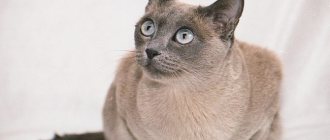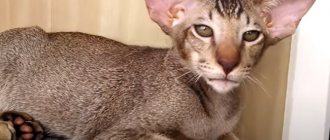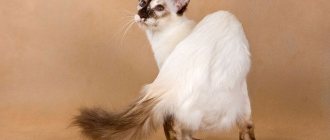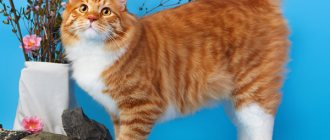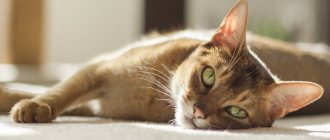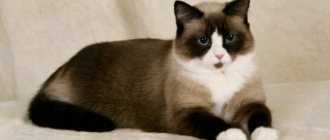History of the breed
There is a version that the first mention of these animals is found in the treatises of Siam and it was these animals that were brought to England in the nineteenth century under the guise of a chocolate Siamese. But the Siamese cat breed standard was formed in a different way and has undergone great changes.
Whether the Tonkinese cat is an “old” type of Siamese or not will never be known for certain, no matter how much felinologists argue.
In the sixties of the last century, Canadian breeder Margaret Conroy got a kitten by crossing Siamese and Burmese breeds and began to work on a new variety, naming it after the Vietnamese region of Tonkin. After the standard was written, many years of breeding work took place.
For fifteen years this cat was listed as a hybrid breed. True, this variety was originally called the “golden Siamese” because of its characteristic mink-like coat and color-point color.
The history of the name of the breed is romantic. In the USA there is a popular musical about the love of an American officer and a Tonkinese girl - the story takes place on the Pacific Islands. The moral of the story is the victory of high feeling over racial prejudice. The difficult fate of these cats, their long lack of recognition was the reason for this analogy. But the name “Tonkinese” was originally associated with the musical, in which the main character is a resident of Tonkin.
An Old Siamese cat named Wong Mau was brought to the United States of America by Dr. Joseph Thompson back in 1930. Her descendants became breeding animals - they were crossed with the Canadian line and the march of the Tonkinese cat began in America.
Today this breed is recognized by all felinological associations, but there are two standards: European and American.
Attachment to family
Cats get along well with one person or in large families. The main thing is to respect your pet and pay attention to it every day. If there are already other animals in the house, the Tonkinese kitten will quickly get used to them. This breed will even establish contact with birds and hamsters.
When bringing adult animals into your home, remember that Tonkinese are quite picky about the issue of personal space. They may see the presence of other small animals as a problem.
Features and breed standard
In terms of morphology, the Tonkinese cat resembles a Thai cat, but has a shorter and wider, slightly snub nose. This is an animal of medium size and constitution with a peculiar coat and a characteristic color point. Derived from crossing a Siamese and a Burmese, it is distinguished by its aquamarine eye color.
Description given to this breed by WCF:
- Head. Wedge-shaped, quite wide. The profile and cheekbones are quite softly outlined, the stop is small in size on the bridge of the nose.
- Neck. Medium size, strong and muscular.
- Eyes. Quite widely spaced, almond-shaped, but slightly rounded. The color must match the coat. From aquamarine to seawater color. Preferably clean and clear tones.
- Ears. The middle ones are wider at the base, tapering to slightly rounded tips. High standing, straight, not too wide apart. The fur on the ears is short, the ears appear translucent.
- Body. Medium build, muscular, with a toned stomach. Not elegant, but not massive either.
- Paws. Medium size, quite graceful, but strong, pads are round, but quite small.
- Tail. Medium size, proportional to the body, slightly tapering towards the tip.
- Wool. Short and shiny. Without undercoat, lying close to the body.
- Color. The main background is without a pattern, uniform, somewhat lighter on the inner parts of the body. The points—the “mask” on the face, the ears, paws, and tail—are darker, the transition from the main background to the points is smoothed out.
- Weight. Males are larger than females. From three to six kilograms.
- Knitting. Interbreeding only within the breed
- Flaws. Slight deformation of the tail, too heavy or graceful body, large snub nose.
Disqualifying signs:
- Yellow eye color
- White spots and medallions
- Tail break
- Aggressive behavior.
Colors
This is the only cat whose six, one of the main advantages of the breed, are compared to a mink. It was the delicate shades of color and its brilliant gloss - glitter - that gave the colors such a name.
There are five main colors of the Tonkinese cat. Their characteristics:
- Natural mink. The main background is light brown, the points are dark brown. The abdomen and inner surfaces of the paws are lighter than the rest of the body. The paw pads and nose are light to dark brown.
- Honey mink. The main background is cream with a golden-apricot tint. The points are red-brown of varying intensity. The paw pads and nose are the color of pink caramel.
- Champagne. The main background is light cream, the points are light brown. The paw pads and nose are a cinnamon shade of varying intensity.
- Blue mink. The main background is light gray with a bluish tint, the points are darker, smoky blue. Paw pads and nose - match the background color.
- Platinum mink. The main background is silver-gray, almost purple. Points are the same color, but more saturated with a purple gloss. The paw pads and nose are pink to gray with a lavender tint.
Some felinological systems combine honey and champagne mink into one category. In addition, the Siamese type of color is sometimes recognized - with a clear contrast from the background to the points, a solid Burmese color. The mink color is often classified as a mink color.
The formation of colors is completely completed no earlier than one and a half years. Therefore, in kittens and young individuals, lighter background colors and faint spots in the points are allowed.
Origin
The history of the origin of Tonkinese cats, or Tonkinese, is very complicated - cats with the corresponding appearance appeared in different centuries in different parts of the world.
In Asia in the 17th-18th centuries, similar cats were favorites of aristocrats, and in Europe, the first mentions of “Siamese” cats with an unusual golden color and sea-green eyes lead to England at the end of the 19th century.
But, of course, there is no evidence that these were the first representatives of the Tonkinese breed, therefore these are only beautiful legends.
Directed selection of the breed began a little more than half a century ago in Canada. Felinologist Margaret Conroy conducted an experiment: she crossed a Siamese cat with a Burmese cat, wanting to get the Burmese body shape and the acromelanic color of the Siamese. The first litter was successful - the kittens were born with light brown fur and aquamarine eyes. The breed was called the “Siamese golden cat.”
Since 1965, the breed began to participate in Canadian exhibitions. In 1971, the Golden Siamese cat was renamed the Tonkinese cat, and a few years later the Tonkinese cat was officially recognized in Canada, America and Great Britain.
Character
The Tonkinese has taken the best from both breeds that created it. He is energetic and active, like a Siamese, but more silent, obedient and flexible, like a Burmese.
The soft and loyal pet always tries to be close to its owner. Strives to be picked up and loves to sleep with people.
Just like the Siamese, they love to talk, but at the same time they make quiet meowing sounds and are not so intrusive. They will feel sad when they are alone, so it is better to have a couple of these cats at home or, in addition to Tonkinesis, buy other pets.
They are smart, quickly learn to use the toilet and scratching post, and love to go for long walks with their owner on a leash, if you instill a love for a harness at an early age.
Castration and sterilization
Castration involves the complete removal of an animal's genitals. This will deprive the cat of the testes, and the cat - the uterus and ovaries. This type of operation is more effective and does not leave the animal handicapped.
Sterilization involves eliminating the possibility of becoming pregnant without removing organs. For cats, the spermatic cords are surgically ligated, and for cats, the ovaries are ligated (or the uterus is removed). This method preserves all hormonal urges in pets and, as a result, the habit of cats to mark territory, and cats to attract the attention of the male with loud cries. It is also common for both sexes to experience discomfort in the absence of a partner.
At what age is it recommended to have surgery?
Cats are spayed between 7 and 12 months of age and neutered after reaching 8 months. Cats are operated on between the ages of 10 months and 1.5–2 years. The exact period must be clarified during a consultation with a veterinarian. When choosing the moment for the operation, you need to pay attention to the fact that the younger the animal, the easier it will tolerate the procedure.
Education, maintenance and care
Tonkinese is very easy to care for. The wool has no undercoat, shedding does not bother either the owner or the animal. It is enough to remove sparse changing hair from the pet’s body with wet hands.
There is also no need for combing. To massage the skin, this procedure, if the cat likes it, can be carried out once a week. But this must be done carefully, with a brush with a soft hair base, so as not to damage the delicate skin.
You should not leave your cat alone near an open window, especially on high floors. Playfulness is characteristic even of older animals. If you get carried away with hunting for insects, they can easily fall out.
Tokinesis has virtually no drawbacks; its second name, Golden Siamese, suits it extremely well.
Health and nutrition
Any cat can eat natural food. But in this case, it is very difficult to organize a balanced diet; it is necessary to use additional special supplements and vitamins. Therefore, after kittens are weaned from their mother, they are gradually transferred to super-premium dry ready-made food.
These are heat-loving animals; drafts should be avoided. Prolonged exposure to the sun is also useless - delicate fur can fade.
No characteristic diseases have been noted in this breed. As you age, gum problems may arise. To prevent them, you should be attentive to your pet and promptly contact a veterinarian.
To prevent diseases it is necessary:
- deworm the animal once every three months;
- regularly treat external parasites;
- Be vaccinated annually against rabies and all known feline infections.
Tonkinese cat (Tonkinese) - reviews
- + Leave a review
Leave a review Reset
Nadezhda Tonk
https://irecommend.ru/content/udivitelnaya-koshka
My acquaintance with these amazing creatures took place a very long time ago. I once had cats of other breeds, but after the appearance of Tonkin cats, everything changed dramatically. I have never had such smart and humane cats. That’s why I call them not cats, but creatures, because they are almost not cats anymore. My friends call them “cat+dog+monkey+ferret+man”. They talk, and speak in complete sentences, answer your questions and tell you how they spent the day in your absence. They rumble, they always rumble :) When you look at them, when they want to attract your attention, when they sit on your lap or on your shoulder, when they sleep :) By the way, they sleep in the most imposing positions, preferably on the bed, and often under blanket - on the pillow. They are medicinal - this is an indisputable and confirmed fact. This particular breed of cat is even used in rehabilitation programs for disabled children and in zootherapy programs. This is a cat that will always participate in everything - it will help you around the house, garden, raise and nurse children. But they are also a very curious cat, for this reason they often have to be pulled out of various sticky situations and hard-to-reach places. But with proper attention and love on your part, this animal will create comfort in your home and give you joy. Another important point is that the Tonkinese have a magical ability to unite families and resolve family conflicts. They do not tolerate a tense situation in the house, and will do everything possible to soften and defuse it. These cats are very human-oriented. They need the presence of their beloved owner. They suffer a lot and feel abandoned when no one is home. Therefore, if you work all day, get your Tonkinese friend a second Tonkin, then in your absence they will not be bored, but imagine double the joy when they meet you at the doorstep :))
_Ilnar_
https://irecommend.ru/content/tonkinskaya-prelest-raduet-kazhdyi-den-provedennyi-u-roditelei-fotografii
I want to tell you about my parents’ beloved cat, who warms the heart of my parents’ home every day.
I’ll start from the very beginning, a very charming person has been living with my parents for the second year now, her name is Mila. She was given by a friend of my father, who breeds and sells rare breeds of cats, and everyone liked this gift. At first, this little miracle didn’t cause us much trouble, because she was shy and was just getting used to the new place.
After she completely settled into her new home, Mila played with everything she could. I remember she broke my mother’s favorite vase, bought at a resort in Sharm El-Sheikh (who doesn’t know, this is in Egypt), but my mother could not be angry with her for long because her eyes were so guilty that my mother immediately forgave her. Mila mainly eats dry food, she can snack on anything that can be in the refrigerator or in the closet, she loves carrots (but only lick them), and in the summer she loves to chew green grass, and especially loves to snack on watermelon.
But her favorite was and remains MILK.
Every time I come to visit my parents, she greets me from the doorway and climbs onto my shoulder, purrs and rubs against my head. He likes to play “elusive red dot” and “mouse on a string” with me.
Her parents wanted to sterilize her, but I was immediately against it and convinced them that this was not necessary. I just don’t understand how you can do this to an animal...
Mila herself is a very beautiful cat, smart and very, very gentle.
In general, I can talk for a long time on this topic, but it’s pointless, it’s better to buy such a beauty yourself and enjoy it.
MomDaughter
https://irecommend.ru/content/ni-v-skazke-skazat-ni-perom-opisat-1
Hello! Pour yourself some tea, because the story is not going to be short.
The time has come for me to write a review about this breed (I waited a long time for this to be objective)!
I don't ! The breeders' words about the Tonkinese cat are 100% true, but I will add my own observations to the story.
Our cat’s name is Pakin - this is my daughter’s version of the nickname Liping (from Chinese “gift”), which the male half of the family liked and was supported, although now she calls him Kapatin, to which my grandmother said that this is similar to the name of the medicine for blood pressure - “Kapoten” " Well, so be it - he is not picky about his nickname! And in general he doesn’t find fault with anything!
Have you ever felt like a god who is worshiped, whose movements are watched every second, who they always want to be next to, want to communicate, look into your eyes, your very appearance in the field of vision causes trembling delight and a desire to touch, and, in turn, do they fall into endless bliss from your touch and turn on a continuous purr? Feel it - get a Tonkinese!
Do you like it when the cat doesn’t go anywhere without receiving your approval and it’s enough to stop the unwanted action with an almost one-time “no”, without using newspapers, sprinklers, etc.? Get a Tonkinese!
And you will like, having a small child, not to be afraid that he will be scratched or bitten by a cat, while your baby will be completely delighted with playing together with the cat, and if the child is too intrusive, the cat will gently wriggle out of the baby’s tenacious fingers and hide to a corner, however, just for a break before a new series of exciting games? Get a Tonkinese!
Among your family members there are anti-worshippers of the meowing brethren, but you cannot live without purring? Get a Tonkinese cat - they won’t be able to live without him either!)))) Will you be pleased not to be jealous of anyone for your cat, because he prefers one person as the “main”, and condescends to the rest “with his mercy”? Get a Tonkinese!
Now some will wince after reading my description and say: “Ugh! What it is? Is this a cat? The cat should walk on its own!” and... they will be mistaken that Tonkinese is a “plasticine” creature. No! He is a CAT, that’s right - with a capital C! A cat walking by himself! How is this compatible? There’s no way to describe it - meet Tonkinese cats and you’ll understand everything!
His character is such that he knows how to find the “key” to each family member! He will be able to find the right poses, looks, gestures, so that people will admire him, be touched, want to stroke him, and... even be afraid to touch him in sacred awe (I observed such a scene), while he will not be arrogant like a star, but, on the contrary, will be very friendly and delicate!
He does not tolerate disharmony and will strive by all available means to establish balance in the environment around him, and what it will be - disappearing from sight, jumping on cabinets, obsession or peaceful upper-abdominal lying - he will choose for himself!
Regarding my Pakin, I regret 2 things:
- that I didn’t start him earlier - I lost so many minutes of communication and
- that she didn’t do it later - a small child enthusiastically screaming during the ultrasound, “The kitty is grazing!” (the kitty woke up) caused the cat to have a lightning-fast reaction of disappearing into the far corner, which prevented Kapatishka from adapting more quickly to our house.
However, as you understand, I regret the latter less and less - he doesn’t play with anyone, like his daughter, selflessly and recklessly with a swing and doesn’t rush to catch up across the entire apartment!
Does he heal? (this was my mother-in-law's question). I don’t know what to consider “treatment” - is it pain relief after he lay next to the sore spot near my back? Or the fact that my daughter, after moving to us, began to speak in complex sentences, and before that we even went to doctors because of speech problems? Or, perhaps, consider the “cat, come here” reaction of my relatives, who before him held the views “fu-cat - what an abomination - they’re just an infection”, as treatment?
As you understand, I can talk about Pakin for a long, long, long time and not tell even half of the miracles that I encounter almost every day: this and, at the first meeting, his “mind reading” reaction (there is no other way to say it - it was difficult to choose, because I watched several cats at different times - this is important!)! And the fact that even food cannot be more important for him than communicating with a person! And the fact that not a single impudent face will wake you up at the crack of dawn, demanding that his needs be met - he will adapt to your schedule, and if he needs to do something urgently, he will carefully make it clear, believe me, you will not get angry and You won’t even wake up very much when they gently lift you up to open the door and let you out of the bedroom! And the fact that in a stressful situation, such as a loud sharp sound, he will seek protection from you! And the fact that he agrees to put on a harness, put his claws under the nail clipper, expressing his displeasure only with a more intense request for affection! This is captivating!
Do I recommend a Tonkinese cat? Certainly! … But! not for those who love unobtrusive, inconspicuous cats lying peacefully on the sofa (this is a lap cat, not a sofa cat)! And not for those who are away from home for a long time - Tonkins are really over-curious and even if they don’t destroy your apartment in your absence, but while looking for entertainment, they can seriously suffer - Pakin still monitors my reaction if he wants to get into something, something... then explore. I had to explain to him why you shouldn’t want to climb onto an electric stove and why the pantry and dishwasher are dangerous! He is like a small child, studying the world with interest, while for him you are an indicator of “what is good and what is bad” in your home, and, like a small child, he will persistently strive for the desired item... until you give it, or intelligibly ( without aggression and punishment!) Explain why this is not useful for him (they are sensitive to intonation)!
He is that same delicate, fragile vase made of Chinese porcelain that has come to life, however, not allowing itself to be offended by anyone except... a person. He will endure anything from a person, so do not test his strength in any situation, and he will give you all the affection, delicacy and love that his small but lovingly quivering heart is capable of!
This is love, affection, tenderness and delicacy in a cube, with “0” aggression!
GalaTs
https://rostovmama.ru/forum/index.php?topic=157503.0
From the descriptions of the happy owners, I knew that the breed took the most interesting features from two ancestral ones: the intelligence and curiosity of the Siamese, the playfulness and short fur coat of the Burmese, plus both of these breeds are distinguished by a desire for communication and human dependence. In reality, I gasped! Our Heidi had everything marked “hyper”: purriness, mobility, affectionateness, curiosity. I warn you right away: tonkins are not suitable for people who are bothered by the stickiness of cats! There are also such people, and quite a few, among our friends and relatives. Not everyone who comes likes that the cat often asks to be the center of attention. She doesn’t yell, doesn’t fall under her feet... But she’ll just jump on your shoulder and roll around. Or it will spread out under your arm on your lap: pet me, I’m soft!! I don’t know who, but the family members are dragging along)))
They come in different colors. I won’t bore you, in short, it’s a cool game of genetics. There are solid (solid) “Burmese” colors, point “Siamese”, and exclusively “Tonkinese” mink (mink) colors. Almost the same as the Siamese, but the body is not white, but also has a tone. I liked the “chocolate” variations the most)) That’s why they took the baby just like that. At the same time, she has amazing eyes the color of aquamarine, greenish-blue, the color changes with different light conditions and her mood)
Not a cat - but a chameleon) Considering that over time the color saturation should increase.
Julia
https://cattish.ru/breed/tonkinese/?reviews=1
My Malvina is the eighth wonder of the world. The cat will bewitch anyone who just looks at it. Only this breed has aquamarine eyes. Not blue like the Siamese, but sea green! She is a small, graceful cat. The progenitors were Siamese and Burmese cats.
My very long-awaited “daughter”, I’ve been waiting for the litter for more than a year. She loves communication, attention to herself, she is used to going to exhibitions, and rides with me in the car. Smart, active, playful like the breed. Where the bag rustled, I know my blue Malvina is already there
